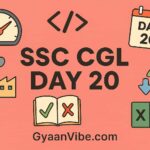GyaanVibe is a focused educational platform dedicated to helping SSC CGL aspirants crack Tier 1 & Tier 2 exam with a strategic, day-wise, and well-structured preparation approach.
SSC CGL Preparation – Day 16
Quantitative Aptitude: Time, Speed, and Distance (TSD)
🔹 1. Key Concepts
🟢 Basic Formulas
- Speed = Distance / Time
- Time = Distance / Speed
- Distance = Speed × Time
🟡 Units Conversion
| Unit |
|---|
| 1 km = 1000 meters |
| 1 hour = 60 minutes = 3600 seconds |
| 1 m/s = 18/5 km/h |
| 1 km/h = 5/18 m/s |
To convert:
- m/s → km/h: multiply by 18/5
- km/h → m/s: multiply by 5/18
🔹 2. Average Speed
If the same distance is covered at two different speeds: $$\text{Average Speed} = \frac{2xy}{x + y}$$
where x and y are the speeds for equal distances.
If distances are different: $$\text{Average Speed} = \frac{\text{Total Distance}}{\text{Total Time}}$$
🔹 3. Relative Speed
Used when two objects move towards or away from each other.
🔸 Same direction:
$$\text{Relative Speed} = \text{Difference of speeds}$$
🔸 Opposite direction:
$$\text{Relative Speed} = \text{Sum of speeds}$$
Remember to keep units consistent!
🔹 4. Meeting Point Problems
When two objects start at the same time from different points and move towards each other: $$\text{Time to meet} = \frac{\text{Distance between them}}{\text{Relative speed}}$$
🔹 5. Train Problems
- Length of train = speed × time
🛤️ If a train crosses a stationary object (pole/tree/person):
$$\text{Time} = \frac{\text{Length of train}}{\text{Speed of train}}$$
🛤️ If a train crosses a platform (or bridge):
$$\text{Time} = \frac{\text{Length of train + Length of platform}}{\text{Speed}}$$
🛤️ Two trains crossing each other:
- Opposite directions: Relative speed = sum of speeds
- Same direction: Relative speed = difference of speeds
Time = (Sum of lengths) / Relative speed
🔹 6. Boats and Streams
Let:
- b = speed of boat in still water
- s = speed of stream
Then,
- Downstream speed = b + s
- Upstream speed = b − s
➤ Formulas:
- Time = Distance / Speed (use upstream/downstream accordingly)
🔹 7. Races
- Lead: Difference in distance covered when one reaches the finish
- If A beats B by
dmeters in a race ofxmeters, and B finishes in timet: $$\text{Ratio of speeds} = \frac{x}{x – d}$$
🔹 8. Important Shortcuts
| Situation | Shortcut |
|---|---|
| Two speeds x and y, same distance | Average speed = (2xy)/(x+y) |
| Time taken to meet = d / (x ± y) | Depends on direction |
| Train crosses man/pole | Time = Train length / Speed |
| Train crosses platform | Time = (Train + Platform length) / Speed |
| Boat downstream time = D/(b + s) | Upstream = D/(b − s) |
🧠 Tips for SSC CGL
- Time-speed-distance problems are often logic + calculation.
- Always check units (m/s vs km/h).
- In race/boat problems, identify which speed is being referred to.
- Practice train problems with varying objects: poles, platforms, persons.
✅ Example Problems
🔸 Q1: A train 120 m long runs at 54 km/h. How much time will it take to pass a man standing on a platform?
Solution:
Speed = 54 km/h = (54 × 5)/18 = 15 m/s
Time = 120 / 15 = 8 seconds
🔸 Q2: A man can row 30 km downstream in 3 hours and the same distance upstream in 6 hours. What is the speed of the boat in still water?
Solution:
Downstream speed = 30/3 = 10 km/h
Upstream speed = 30/6 = 5 km/h
Speed in still water = (10 + 5)/2 = 7.5 km/h
🔸 Q3: Two trains of lengths 150 m and 200 m are running in opposite directions at 60 km/h and 90 km/h. In how much time will they cross each other?
Solution:
Relative speed = 60 + 90 = 150 km/h = (150 × 5)/18 = 125/3 m/s
Total length = 150 + 200 = 350 m
Time = 350 ÷ (125/3) = (350 × 3)/125 = 8.4 seconds




